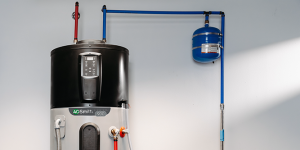What we’ll cover
-
How to set a timeline and budget
-
Home equity options for renovations
-
Saving strategies for cash payments
Whether it’s a facelift or a full-on remodel, you’ve decided it’s time to give your home a little extra TLC . But you might not have the cash on hand to gut your kitchen or upgrade your curb appeal — and that’s okay. Fortunately, if you’re taking on a major (or minor) home project, now’s your opportunity to get to know some of the best ways to finance a home improvement project.
First things first: Set a timeline and budget.
Before you set your heart on a range of gleaming new kitchen appliances or a house-wide smart home system, it’s a good idea to determine your timeline and your budget. Are you hoping to begin your renovation in the next few weeks? Or are you okay with starting in a year? If you are flexible with your timing, you might be able to spend a few extra weeks or months saving up for your project, or you could focus on beefing up your credit score before you seek out financing, if necessary.
You’ll also want to create a realistic budget for your project. Whether you plan to DIY or work with a contractor, make sure to do plenty of research about similar projects and how much they typically cost in your area. You’ll also want to factor in costs for potential surprises and fees, as well as materials and rentals if you’re DIYing. And if you plan on hiring a pro, seek out several bids to see the potential price range for your project.
Related: 5 budgeting methods to mix and match
Best ways to finance home improvements
Once you have an accurate estimate in mind for your renovation, remodel, or upgrade, you can consider your borrowing and financing options. We’ve outlined several options below for you.
1. Mortgage refinance
If you prefer to avoid taking out a loan for your home improvement venture, a cash-out mortgage refinance is an option that could help you access thousands of dollars. With this type of refinance, you tap into your home’s equity (which is your home’s value minus your remaining mortgage balance). You get a new mortgage with an outstanding balance that’s higher than your current one, and you receive the difference between the two loans in cash. To qualify for a cash-out refinance, you typically need to have at least 20% equity in your home, as this type of mortgage refinance can pose more risk to lenders.
A cash-out refi can make sense for larger projects, like a kitchen reno or room addition. For smaller projects (like new light fixtures or replacing the front door), a rate-and-term refinance could help you lower your monthly payment and free up cash in your monthly budget. With this type of refinancing, you replace your original mortgage with a new one — typically at a lower interest rate. Keep in mind, this option will only lower your monthly payment if you extend your loan term (or keep it the same with a lower interest rate). If interest rates are low when you’re considering refinancing, use our Mortgage Refinance Calculator to see how much money you could save on your monthly payments, and then decide if a refi could give you the cash boost you need now to work on your home.
Read more: Avoid these 8 home refinancing mistakes
2. Home equity loan
Another way to finance a major project is by taking out a home equity loan, which is sometimes called a second mortgage. To qualify for a home equity loan, lenders typically require you to have a loan-to-value ratio of 80% or less, which means you’d need to have at least 20% equity in your home. For example, if your home’s total value is $200,000, you would need to have at least $40,000 in equity.
When you take out this type of loan, you receive the money as a lump sum of cash. (Many lenders won’t let you borrow less than $25,000.) And, like a first mortgage , you may have to pay similar closing costs, like loan-processing fees, origination fees, and more. So, you should be prepared to pay an extra 2 to 5% of your loan amount in fees.
Similar to a fixed-rate mortgage, home equity loans are repaid with consistent monthly payments over several years. You will typically have a fixed interest rate, and because they are secured loans (meaning your home acts as collateral), you may be able to get a lower interest rate than you could with a personal loan (more on these in a bit). Still, interest rates on home equity loans tend to be higher than typical mortgage rates — and missing payments means your lender could potentially assume ownership of your home.
If you know exactly how much you need to borrow, prefer a predictable repayment schedule, and would like to tap into your home’s equity as opposed to taking out a personal loan, a home equity loan could be a smart option for your renovation.
Although Ally doesn’t currently provide home equity loans, it may be a viable option to pursue if you qualify and have at least 15 to 20% equity in your home
3. Home equity line of credit (HELOC)
Home equity lines of credit (HELOCs) are similar to home equity loans — they both let you tap into your home’s equity, and you usually need at least 20% equity to qualify. But HELOCs work a bit differently and can be more flexible. Instead of providing a one-time sum of cash, HELOCs allow your home’s equity to act as a source of revolving credit that you can use when you need to — sort of like a credit card.
HELOCs typically don’t have closing costs like home equity loans, but do often have variable interest rates, and the repayment schedule is quite different. The loan has two phases: the draw period and repayment period. The draw period is usually 10 years and you can use your available credit as needed during this time. For any funds you borrow, you’ll typically make interest-only payments. Then, during the repayment period (which may be around 15 to 20 years), you can no longer draw funds, and your monthly payments include principal and interest.
If you are taking on a long-term or multi-phase home renovation, a HELOC could be a good choice. That’s because you have more flexibility to tap into your line of credit when you need to, and you don’t have to pay interest on the money you don’t need. Just remember, as a secured loan, HELOCs are backed by your home — so any missed payments can put your home at risk of foreclosure.
4. Personal loan
If you don’t want to use your home’s equity as collateral or don’t have enough equity in your home to do so, you might consider a personal loan for your home improvement project. Personal loans are typically easy to find, as many banks, lenders, and credit unions offer them, including Ally. So, you can shop around to find the best rate (and lowest fees).
Personal loans aren’t backed by your home or another asset, making them unsecured loans. Your interest rate will depend on your credit score and history — the higher your score, the better chance you have at snagging a lower interest rate. But just like a mortgage or other large loan, it’s a good idea to compare rates from a few lenders.
If you have a strong credit score and would prefer a quick payout, a personal loan could be a great option for financing a small to midsize home improvement project. Check if your contractor or home improvement provider offers Ally Lending as a financing option. You’ll need to check if your contractor works with us — and if they don’t, you can ask if they can apply for enrollment.
5. Credit card
For smaller projects — you know, replacing bathroom tiles as opposed to your whole plumbing system — you might consider financing with a credit card. Many credit cards offer low-to-no interest rates for the first few months, so if it’s a project that you can pay for in just weeks (not years), you could possibly avoid owing any interest at all.
One other perk of using a credit card is the potential to earn rewards. If your credit card offers great cash-back or points for your spending, this could help you reap those benefits. But if you aren’t in a 0% APR (annual percentage rate) introductory period, you’ll want to pay off your project quickly, because credit card rates can be exceptionally high compared to other financing options.
6. Cash
Finally, if you want to avoid dealing with loans, fees, interest, and more, you could opt to pay for your home improvement in cash. This option may only make sense for smaller projects. (Another alternative: You might choose to pay for a portion of your home improvement venture in cash.) Either way, paying out of pocket can help eliminate the extra costs that come with a loan or refinancing, which may help you stay within your budget.
If you plan to pay in cash, you may need to practice patience as you save up. Opting to store your savings in a savings account can help you get there faster. With our Online Savings Account , you can even store your savings in a bucket exclusively earmarked for your renovation or repair and stay on top of exactly how you’re tracking against your goals.
No matter if you’ve been planning to install an in-ground pool for years or you’re suddenly faced with a roof repair that needs to be taken care of ASAP, you have several financing options to improve your home. With such a range of options, you can find one that makes the most sense for you based on financial factors (specifically your home’s equity and your credit score), as well as personal preferences (like how and when you’ll pay back your loan). From refinancing to personal loans to plain-n’-simple cash: You can make your home HGTV-worthy by giving it the TLC it needs.
Read the full article here














